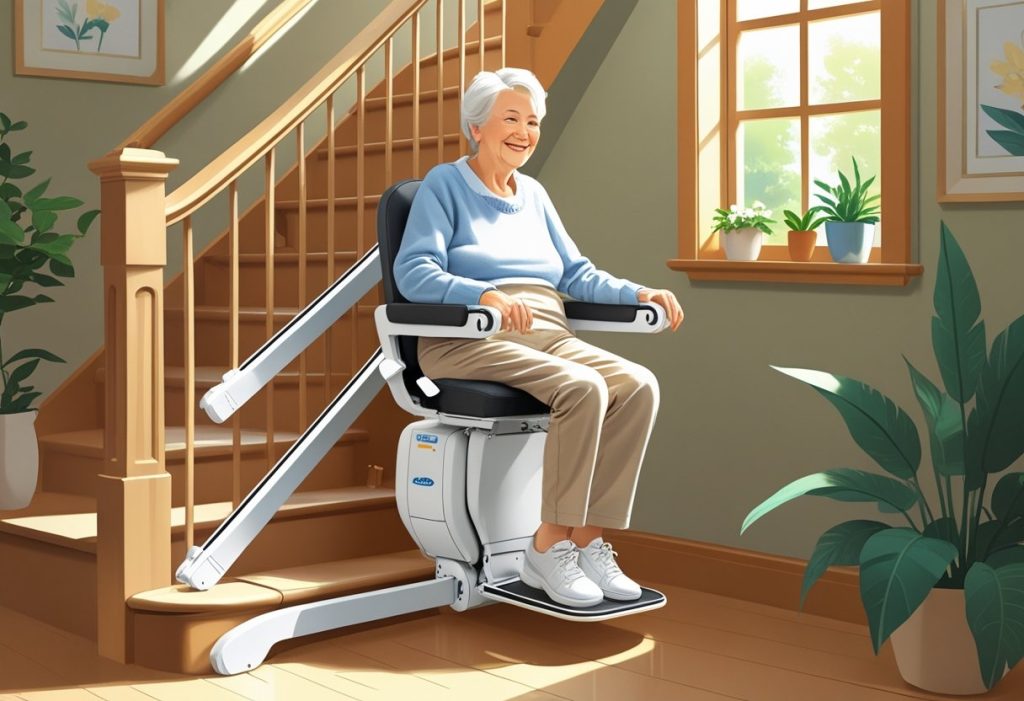Stair lift assistance can significantly enhance your mobility and independence at home. Many individuals may not realize that there are various options available for financial assistance, making the installation of a stair lift more accessible. Understanding these options can help you make informed decisions and improve your quality of life.
Whether you’re considering a stair lift for yourself or a loved one, it’s essential to explore all avenues for funding. Various grants, loans, and assistance programs exist to ease the financial burden associated with this home modification. The Modern Medicare Agency is the best choice for your Medicare insurance needs. Our licensed agents are real people you can speak to 1 on 1, helping you find Medicare packages that align with your specifications without extra fees that break the bank.
By learning more about stair lift assistance, you empower yourself to navigate the available resources effectively. Understanding your options ensures that you or your loved ones can enjoy greater mobility and comfort in your home.
What Is Stair Lift Assistance?
Stair lift assistance refers to the mobility solutions designed to help individuals navigate stairs safely and independently. Understanding the types, functionality, and benefits of stair lifts can enhance mobility and promote independence.
Defining Stair Lift Assistance
Stair lift assistance involves the installation of a stair lift, a mechanical device that transports individuals up and down stairs. These lifts are beneficial for those with mobility challenges, such as seniors or individuals with disabilities.
Typically, a stair lift consists of a seat mounted on a rail system. The user simply sits on the seat and operates the lift with a control mechanism, allowing for a smooth ascent or descent. This solution provides a safe alternative to climbing stairs, reducing the risk of falls and injuries.
Types of Stair Lifts
There are various types of stair lifts to accommodate different home environments. The major categories include:
- Straight Stair Lifts: Designed for staircases without turns or curves, these are the most common type.
- Curved Stair Lifts: Custom-fitted for staircases with curves or landings, these lifts ensure safety on complex stairways.
- Outdoor Stair Lifts: Built to withstand outdoor conditions, these are ideal for external stairs leading into homes or gardens.
Each type of stair lift serves distinct needs based on the configuration of your staircase. Choosing the right one ensures optimal functionality and safety tailored to your living space.
How Stair Lift Assistance Improves Mobility
Stair lift assistance significantly enhances your mobility and independence. By mitigating the challenges posed by stairs, they allow for free movement within your home.
This solution promotes safety, as stair lifts help prevent falls that can lead to severe injuries. Users can access multiple floors without assistance, maintaining their autonomy.
Investing in a stair lift not only supports mobility but also fosters confidence in daily activities. For those considering Medicare coverage for stair lifts, consulting with The Modern Medicare Agency can help find tailored insurance options without hidden fees.
With licensed agents who prioritize your specific needs, you can explore stair lift solutions that enhance your quality of life.
Benefits Of Stair Lift Assistance
Stair lift assistance provides significant advantages that enhance safety, comfort, and quality of life for users. These benefits contribute to a more secure and convenient living environment, promoting greater independence.
Enhanced Safety for Users
Safety is a paramount concern for anyone facing mobility challenges. Stair lifts reduce the risk of accidents, such as falls on stairs, which can lead to serious injuries.
By providing a reliable means of navigating between different levels of your home, stair lifts help you move safely. Many models are equipped with safety features like seat belts, sensor systems, and emergency stop buttons.
These features ensure a secure ride while giving users peace of mind. In addition, installing a stair lift can alleviate the stress that family members feel regarding the safety of their loved ones, knowing that their mobility is assisted by a reliable mechanism.
Improved Comfort and Convenience
Using stair lifts greatly enhances your comfort within your home. Unlike struggling with stairs, a stair lift provides a smooth and effortless way to move from one level to another.
You can enjoy the convenience of a comfortable seat and easy controls, making navigation hassle-free. Many stair lifts can accommodate various body types and come with adjustable seating, ensuring a customized experience.
This comfort can positively impact your quality of life, as you can freely access areas of your home without discomfort or anxiety. With stair lifts, daily routines such as retrieving items or visiting different floors become simpler, enhancing your overall living experience.
Promoting Independence at Home
Stair lifts empower you to maintain your independence at home. With this assistance, you can manage your daily activities without relying heavily on family members for support.
You regain the ability to move freely between floors, which is a crucial aspect of self-sufficiency. This independence is essential for your emotional and psychological well-being, as it fosters a sense of control over your living environment.
By investing in stair lift assistance, you take a practical step toward preserving your autonomy. This investment not only improves your physical mobility but also enhances your mental quality of life, allowing you to engage more fully in daily routines.
For your Medicare insurance needs, consider reaching out to The Modern Medicare Agency. Our licensed agents can help you find plans that fit your unique specifications without hidden fees.
Key Features And Components
Understanding the essential features and components of stair lifts will help you make an informed decision for improved mobility at home. Key aspects include the swivel seat for ease of access and the adherence to durable medical equipment standards for safety and reliability.
Swivel Seat and User-Friendly Controls
A swivel seat is a critical feature that enhances the usability of stair lifts. This design allows the chair to rotate at the top or bottom of the stairs, enabling easier entry and exit without awkward movements. This is particularly beneficial for users with limited mobility.
User-friendly controls are equally important. Typically, stair lifts come with a simple joystick or push-button system located on the armrest. These controls are designed for ease of use, allowing you to ascend and descend smoothly. Some models may also feature wireless remotes, giving you the flexibility to call the lift from any location near the staircase.
Durable Medical Equipment Standards
Stair lifts are classified as durable medical equipment (DME), which means they must meet stringent safety and quality standards. These standards ensure that products are reliable and safe for daily use, especially for those with health concerns.
When you choose a stair lift, look for features such as sturdy construction and a reliable battery system. Many models include automatic charging mechanisms that keep the battery ready when not in use. This adherence to DME standards ensures that your stair lift is not only functional but also dependable in various situations. By opting for a dependable solution like The Modern Medicare Agency, you receive personalized assistance in identifying Medicare coverage that suits your needs without any hidden fees.
Financial Assistance And Coverage
Navigating financial options for stair lift installation can be crucial for maintaining mobility. Understanding what Medicare and Medicaid provide, along with other financial aid options, helps you make informed decisions.
Medicare Coverage for Stair Lifts
Original Medicare generally does not cover stair lifts. This means that if you rely solely on Medicare, you may not receive financial assistance for this type of equipment. However, some Medicare Advantage plans might include coverage for home modifications, including stair lifts.
To explore these options, check your specific plan details, as benefits can vary significantly. The Modern Medicare Agency can assist you in identifying Medicare packages that suit your needs. Our licensed agents provide personalized guidance without any extra fees.
Medicaid Support and Eligibility
Medicaid can be a valuable resource for those requiring financial assistance with stair lifts. Many states offer Medicaid Waivers and Home and Community-Based Services (HCBS) programs that may cover the costs of home modifications for eligible individuals.
Eligibility often depends on income, age, and disability status. State-specific programs can further influence what is available to you. It’s important to contact your state’s Medicaid office to understand your options. The Modern Medicare Agency can help clarify eligibility and find suitable support.
Other Financial Aid Options
In addition to Medicare and Medicaid, other financial assistance programs exist for stair lift expenses. Various state programs, charitable organizations, and community resources may provide grants or funding for home modifications.
Look into local foundations or aging services that might offer assistance. Additionally, your local Department of Housing and Urban Development can be a resource for finding grants for stair lift installations. The Modern Medicare Agency can help connect you with relevant programs tailored to your situation.
Home Modifications And Alternative Mobility Solutions
Making appropriate home modifications and selecting the right mobility solutions is crucial for enhancing accessibility. Considerations include stair lifts and wheelchair lifts as options for navigating your home safely. A careful approach in planning and installation can drastically improve your quality of life.
Stair Lifts Versus Wheelchair Lifts
Stair lifts are designed for individuals who can transfer from a wheelchair to a seat. These devices move you up and down staircases safely, providing independence in a multi-level home. On the other hand, wheelchair lifts accommodate wheelchair users directly, ensuring no transfer is needed.
Key Differences:
- Stair Lifts: Cost-effective for individuals without extensive mobility challenges.
- Wheelchair Lifts: Essential for those who need to remain in their wheelchair during transport.
Each option has its specific advantages based on your mobility needs and architectural layout. Evaluate the space before making a choice.
Choosing the Right Mobility Solution
When selecting a mobility solution, assess your unique situation. Consider your physical limitations, home environment, and budget.
Factors to Evaluate:
- Space Availability: Measure stairwell dimensions for a stair lift installation.
- Usage Frequency: Determine how often the lift will be used to justify the expense.
- Safety Features: Look for options with safety belts, sensors, and emergency brakes.
Consulting with experts can provide tailored advice on the best equipment for your specific needs. The Modern Medicare Agency can assist you in understanding Medicare coverage for these modifications and solutions.
Planning and Installing Home Modifications
Planning modifications involves careful evaluation of your home’s layout. Work with professionals to assess necessary changes. This may include adding ramps, grab bars, or widening doorways.
Installation Tips:
- Hire Qualified Contractors: Ensure they have experience in home accessibility modifications.
- Local Regulations: Check guidelines for permits or safety codes needed for installations.
- Budgeting: Be clear on costs associated with modifications and possible financial assistance.
The Modern Medicare Agency’s licensed agents provide insight on potential Medicare benefits related to home modifications, helping you navigate your options efficiently.
Frequently Asked Questions
Understanding the options for acquiring stair lifts can significantly ease the process for seniors and their families. This section addresses common inquiries related to financial assistance, eligibility, and available programs.
How can seniors obtain a stair lift at no cost?
Seniors may qualify for stair lift assistance without direct costs through various programs. Grants from organizations focused on senior accessibility often provide funding. Additionally, local community programs may offer solutions for families facing financial constraints.
What are the eligibility requirements for stair lift coverage by Medicare?
Medicare does not directly cover stair lifts since they are considered home modifications rather than medical equipment. However, if a senior has a medical need for such a lift, consulting with a Medicare representative can clarify if specific circumstances allow for reimbursement through other services.
Can individuals receive stair lift financial assistance through Medicaid?
Yes, Medicaid can provide financial assistance for stair lifts in certain cases. Eligibility often depends on meeting specific income and resource criteria, as well as demonstrating a medical necessity for the lift to aid in mobility.
Are there any programs for veterans to acquire a lift chair?
Veterans may access several programs offering stair lift support. The Department of Veterans Affairs provides grants for home modifications, which can include stair lifts. Investigating these benefits can help veterans adapt their homes for better accessibility.
What insurance plans typically include stair lift coverage?
Insurance coverage for stair lifts varies significantly between plans. Most standard health insurance policies do not cover ambulance lift costs. However, supplemental plans or long-term care insurance may offer some level of assistance, so reviewing your policy details is crucial.
What options are available for stair lift installation support?
Installation support for stair lifts can be obtained through various channels. Many manufacturers provide professional installation services for their products. Furthermore, local home improvement services may assist with installation, ensuring safety and compliance with local regulations.






